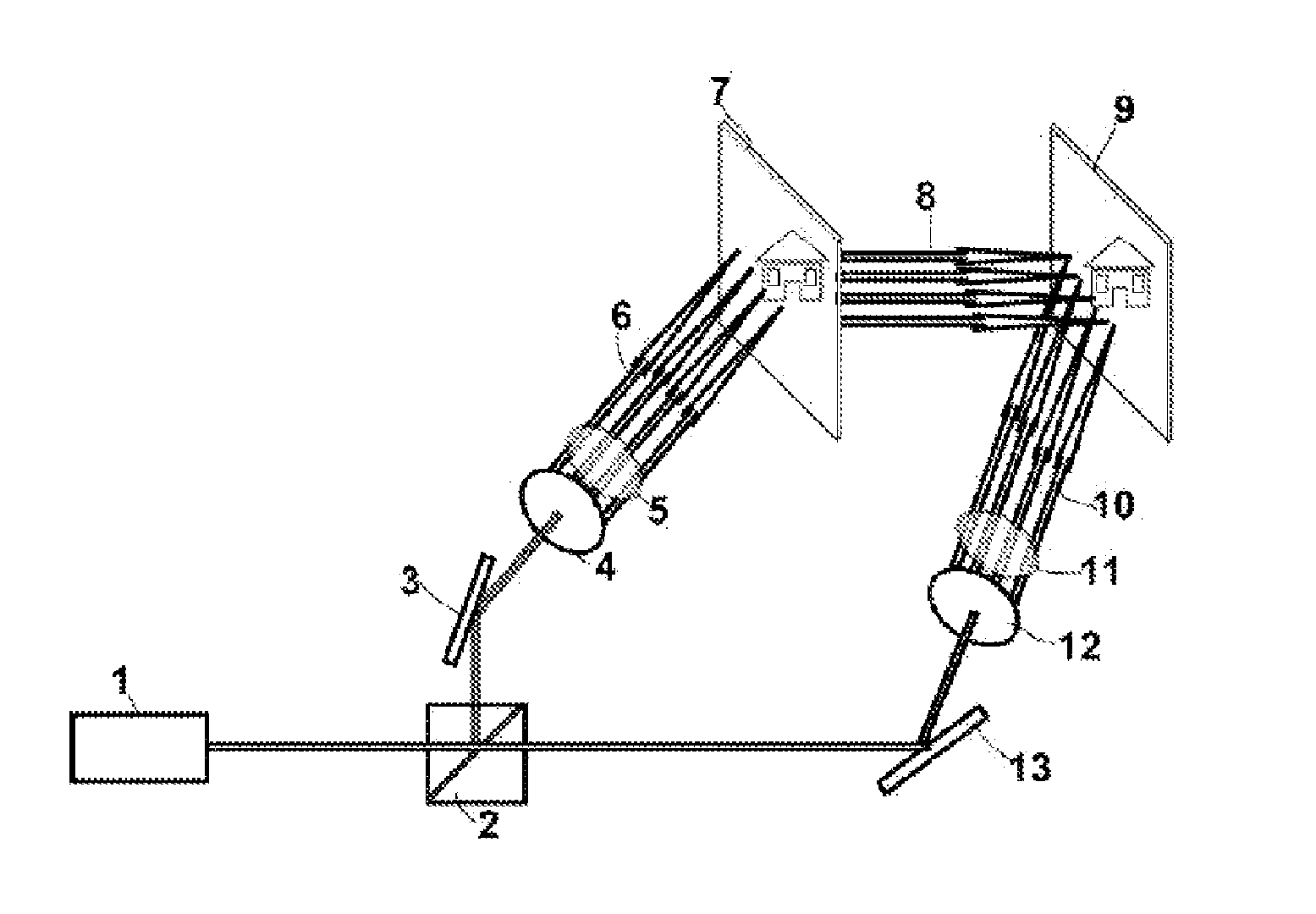Method for preparing colorful three-dimensional hologram based on holographic polymer dispersed liquid crystal grating
a liquid crystal grating and polymer technology, applied in the field of functional materials, can solve the problems of inability to use most polymers in practice, inefficiency of diffraction, and no report on the method for preparing a colorful three-dimensional hologram based on holographic polymer dispersed liquid crystal gratings
- Summary
- Abstract
- Description
- Claims
- Application Information
AI Technical Summary
Benefits of technology
Problems solved by technology
Method used
Image
Examples
embodiment 1
[0033]In the 441.6 nm laser interference field, prepare with holography a holographic master storing the reflected (or transmitted) light wave information (amplitude and phase) of a captured object, use a beam of object light to irradiate the holographic master at a Bragg angle to generate a beam of diffraction light, use the diffraction light and a reference light to simultaneously irradiate a holographic base board of 10 μm thick, which consists of 0.01 wt % photosensitizers (3,3′-diethyl thiacarbocyanine iodide and coumarin 6 in the proportion of 1:1), 0.1 wt % co-initiators (N,N,N-triethylamine, N-Methyl maleimide, and 3-bromine phenyl glycine in the proportion of 1:1:2), 30 wt % monomers capable of free radical polymerization (methyl methacrylate, methyl acrylamide, and N-vinyl pyrrolidone in the proportion of 2:3:1), and 70 wt % liquid crystals (8CB and 5CT in the proportion of 2:1); when total optical paths of the two laser beams reaching the holographic base board are equiva...
embodiment 2
[0034]In the 441.6 nm laser interference field, prepare with holography a holographic master storing the reflected (or transmitted) light wave information (amplitude and phase) of a captured object, use a beam of object light to irradiate the holographic master at a Bragg angle to generate a beam of diffraction light, use the diffraction light and a reference light to simultaneously irradiate a holographic base board of 15 μm thick, which consists of 0.01 wt % photosensitizers (coumarin 343 and 7-lignocaine-3-thenoylcoumarin in the proportion of 1:2), 0.1 wt % co-initiators (N-ethyl maleimide, N-phenyl glycine, and 2,4,6-tri(trichloromethyl)-1,3,5-triazine in the proportion of 1:2:1), 90 wt % monomers capable of free radical polymerization (butyl acrylate, 2-acrylic acid isooctyl ester, N-isopropyl acrylamide in the proportion of 1:2:1), and 10 wt % liquid crystal E7; when total optical paths of the two laser beams reaching the holographic base board are equivalent to each other, op...
embodiment 3
[0035]In the 441.6 nm laser interference field, prepare with holography a holographic master storing the reflected (or transmitted) light wave information (amplitude and phase) of a captured object, use a beam of object light to irradiate the holographic master at a Bragg angle to generate a beam of diffraction light, use the diffraction light and a reference light to simultaneously irradiate a holographic base board of 15 μm thick, which consists of 0.01 wt % photosensitizers (3,3-carbonyl bis(7-diethylamine coumarin) and 6-hydroxyl-7-methoxyl-4-phenyl coumarin in the proportion of 1:1), 10 wt % co-initiators (triethanolamine, acetyl phenyl glycine, and 3-nitrile phenyl glycine in the proportion of 2:1:1), 70 wt % monomers capable of free radical polymerization (ethyl dimethacrylate, trimethylolpropane trimethyl acrylate, and N-vinyl carbazole in the proportion of 1:1:2), and 20 wt % liquid crystal P0616A; when total optical paths of the two laser beams reaching the holographic bas...
PUM
 Login to View More
Login to View More Abstract
Description
Claims
Application Information
 Login to View More
Login to View More - R&D
- Intellectual Property
- Life Sciences
- Materials
- Tech Scout
- Unparalleled Data Quality
- Higher Quality Content
- 60% Fewer Hallucinations
Browse by: Latest US Patents, China's latest patents, Technical Efficacy Thesaurus, Application Domain, Technology Topic, Popular Technical Reports.
© 2025 PatSnap. All rights reserved.Legal|Privacy policy|Modern Slavery Act Transparency Statement|Sitemap|About US| Contact US: help@patsnap.com


